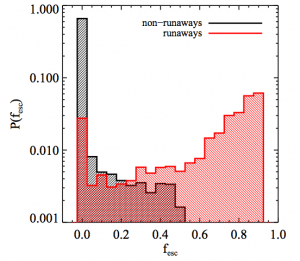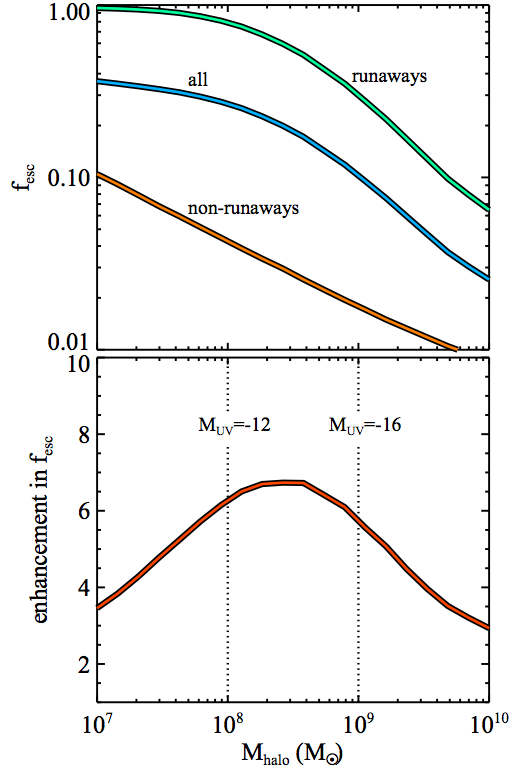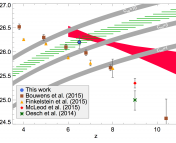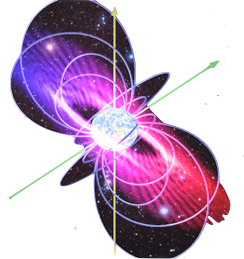• Title: Runaway Stars and the Escape of Ionizing Radiation from High-Redshift Galaxies
• Authors: Charlie Conroy & Kaitlin M. Kratter
• First Author’s Institution: Harvard-Smithsonian Center for Astrophysics, Cambridge, MA, USA
In the early universe, at around a redshift of z~1100 (~380,000 years after the Big Bang), free protons and electrons combined to form neutral hydrogen atoms and left behind a photon afterglow known as the Cosmic Microwave Background. When the universe was older, at z~6-12, the neutral Hydrogen was reionized. During this reionization epoch, the neutral hydrogen atoms absorbed high energy photons (i.e., photons with energies greater than 13.6 eV) causing them to release their bound electrons leaving behind ionized hydrogen. The origin of these high energy photons, usually referred to as ionizing radiation, has been an important topic in cosmology and these authors suggest that the ionizing radiation emitted by runaway massive stars, stars moving at high speeds away from their birth environments, may have significantly contributed to reionizing the neutral hydrogen during this reionization epoch. However, in order for runaway massive stars to contribute significantly to reionization requires that a large amount of the ionizing radiation that they emit escape their host galaxy. In this article, the authors develop a simple analytical model for high redshift galaxies to determine what fraction of ionizing radiation from these stars can escape their host galaxy.
In the local universe (z=0), approximately 30% of massive stars are runaways. These are stars that travel at high velocities (~30 km/s) away from their birth environments. There are two possible mechanisms for forming runaways. The first is due to dynamical ejections from their birth environments which is due to interactions with other nearby stars. Massive stars form in dense (crowded) stellar clusters and usually form in binaries. During their formation and early life they will interact with other stars, which can cause them to be kicked out of their stellar nursery. The second mechanism for the formation of runaways is the ejection of a star due to the explosion from a more massive companion star. Runaways produced via dynamical ejection will travel farther away from their birth place than those produced by the explosion of their companion star because the former will be ejected when the star is very young, whereas the latter will be ejected when it is more evolved. Thus, runaway stars formed by the first mechanism will travel farther from their birth place than those produced by the second mechanism before exploding.

Distribution of the escape fraction of ionizing radiation, fesc,values for stars used in their fiducial model (z=10) for both runaways (red bins) and non-runaway (black bins) stars. The vast majority of non-runaway stars have f_esc = 0, whereas the vast majority of runaway stars have very high f_esc.
Since galaxies in the local universe are quite large these stars are unable to travel to the outskirts of their host galaxy before exploding , so the majority of their ionizing radiation is “trapped” within their host galaxy (i.e., absorbed by neutral hydrogen). However, as we go back in time (i.e., higher redshift) galaxies are much smaller. This suggests that if the galaxy is small enough, say ~100 pc, these stars can easily reach the outskirts, where the hydrogen number density is low, and a significant amount of their ionizing radiation can escape. These ionizing photons can then reionize hydrogen atoms located outside of their host galaxy.
The figure to the left shows the distribution of the fraction of ionizing radiation produced by stars that escapes the galaxy, fesc, for both runaway and non-runaway stars in their fiducial model. In this model, the galaxy is at a redshift of 10, and is located within a dark matter halo with a mass of 108 solar masses. The authors find that most non-runaways have fesc = 0, whereas a large fraction of the ionizing photons from the majority of runaway stars can escape leading to high fesc values for these stars. These values suggest that a large fraction of the ionizing radiation emitted from runaway stars can easily escape their host galaxies and substantially contribute to reionization.

The top panel shows the escape fraction of ionizing radiation, fesc, for runaway only stars, all stars, and non-runaway only stars as a function of halo mass. The bottom panel shows the enhancement in fesc,the ratio of fesc of all the stars to that of the non-runaway stars, as a function of halo mass.
The figure to the right shows the main results of this paper. The top panel shows fesc for all stars, non-runaways only, and runaways only as a function of the halo mass. All groups show a decreasing escape fraction as the halo mass increases. This is because galaxy size depends on the halo mass: a larger halo mass hosts a larger galaxy. They also find that fesc is always largest for the runaway sample and approaches 1 for the smallest halo masses. The second panel shows the enhancement in the escape fraction of ionizing photons by including the effect of runaway stars (i.e., the ratio of fesc of all the stars to that of the non-runaway stars). This enhancement factor falls in between 2-8, suggesting that the number of ionizing photons that escapes the galaxy is substantially enhanced. The enhancement factor decreases for halo masses above 108 solar masses because as the halo mass increases and thus the galaxy size increases, the average distance the runaway stars travel before exploding becomes a smaller fraction of the galaxy size, trapping more photons within the galaxy. The rise in the enhancement factor for the least massive halos to a halo mass of 108 solar masses is due to the fact that fesc for the non-runaway stars is larger for smaller halos.
In this article, the authors have shown that the ionizing radiation from runaway massive stars may substantially contribute to the reionization of the universe. This is because they are able to migrate to the outer, low-density regions of their host galaxies since these galaxies were much more compact in the past. Once these stars have traveled far from their ejection site, a large fraction of their ionizing radiation can escape their host galaxy. Furthermore, the authors find that runaways formed by dynamical ejection typically have a larger escape fraction than those ejected by the explosion of a more massive companion. This is because the former are able to travel farther than the latter before they explode and thus venture farther out in the galaxy.




